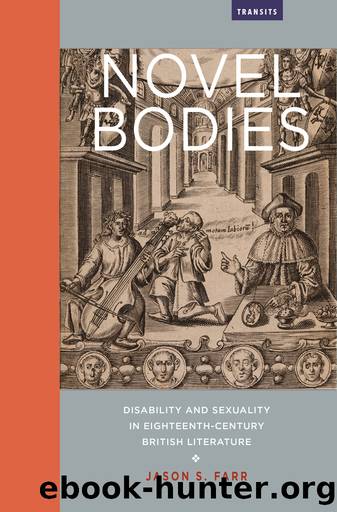Novel Bodies by Jason S. Farr;

Author:Jason S. Farr;
Language: eng
Format: epub
Publisher: Rutgers University Press
NOTES
â â â â 1.â â Armstrong argues that, through her speech and writing, Pamela becomes empowered against aristocratic modes of patriarchy. For Armstrong, the fact that Mr. B. is a member of the older landed gentry is crucial to Richardsonâs reformist rhetoric. In Pamela, the gentry is a âpermeableâ class that one could enter through marriage. Woman is thus shown to ânegotiateâ the terms of her sexual contract, rather than serve as mere object of exchange between men (120). With Pamela, Armstrong argues, Richardson creates a new ruling class, in which a servant girl converts the upper gentry and aristocracy to virtuous domestic values. Armstrong, Desire and Domestic Fiction, 125â141.
â â â â 2.â â Mitchell and Snyder, Narrative Prosthesis, 47.
â â â â 3.â â Siebers, Disability Theory, 30.
â â â â 4.â â Ibid., 7â11. According to Siebers, the âideology of abilityâ is âat it simplest a preference for able-bodiednessâ and âas the baseline by which humanness is determinedâ (8).
â â â â 5.â â Armstrong, Desire and Domestic Fiction, 120.
â â â â 6.â â Watt, The Rise of the Novel, 135â173.
â â â â 7.â â McKeon, The Secret History of Domesticity, 657â658.
â â â â 8.â â Kelleher, Making Love, 131â168.
â â â â 9.â â Richardson, Pamela, 114. All future references to the novel will appear in parenthetical citations.
â â 10.â â Richardsonâs disparaging, colorful description invokes characterizations of male members of the ugly club in Liverpool, from around the same period, who were caricatured in a similar manner. The Ugly Club Manuscript, 1743â1754 gives details about the physical appearance of ugly gentlemen that belong to this social club. In these descriptions, close, satirical attention is paid to an individualâs facial features, such as what may be observed in Mrs. Jewkes. For instance, one John Kenyon is described in the following terms, âA very Oblong Visage. Sallow Complexion. Largeish Eyebrows. Cock Eyeâd. A pretty long Nose. Lanthorn Jaws. On the whole very much like the Picture of King Charles 2nd in a huge full Bottomâd Wig.â The Ugly Club, 38.
â â 11.â â Mitchell and Snyder, Narrative Prosthesis, 53.
â â 12.â â Ibid., 63.
â â 13.â â Ibid., 53.
â â 14.â â Scott, A Journey through Every Stage of Life, 2. All future references to the novel will appear in parenthetical citations.
â â 15.â â Kelly, âIntroductionâ to Millenium Hall, 22.
â â 16.â â Bannet, âLife, Letters, and Tales in Sarah Scottâs A Journey through Every Stage of Life,â 233â259.
â â 17.â â Ula Klein explores same-sex eroticism and cross-dressing in A Journey through Every Stage of Life in âEighteenth-Century Female Cross-Dressers and Their Beards,â 119â143.
â â 18.â â For readings of Fieldingâs The Female Husband, see Castle, âMatters Not Fit to Be Mentioned,â 602â622; and Nicolazzo, âHenry Fieldingâs The Female Husband,â 335â353.
â â 19.â â According to the Vagrant Act of 1744, earning money through fraudulent means, as Leonora does, would be considered an act of vagrancy. See Nicolazzo, âHenry Fieldingâs The Female Husband.â
â â 20.â â Sarah Robinson married Sir George Lewis Scott, a mathematician and tutor to the Prince of Wales. Merely one year after their marriage in 1751, Sarahâs brothers and father removed her from her husbandâs home. As Caroline Gonda and Betty Rizzo both note, the exact reason for the newlywedsâ separation is unknownâthough Gonda surmises that it is likely due to some illicit behavior on Georgeâs part, and Rizzo speculates that he may have had same-sex relations, that he possessed âlibertine inclinations,â or that he discovered a romantic relationship between Sarah and Lady Barbara. See
Download
This site does not store any files on its server. We only index and link to content provided by other sites. Please contact the content providers to delete copyright contents if any and email us, we'll remove relevant links or contents immediately.
Never by Ken Follett(3548)
Fairy Tale by Stephen King(2966)
Reminders of Him: A Novel by Colleen Hoover(2779)
Will by Will Smith(2592)
It Starts With Us (It Ends with Us #2) by Colleen Hoover(2056)
Friends, Lovers, and the Big Terrible Thing by Matthew Perry(2017)
The Becoming by Nora Roberts(1931)
Cloud Cuckoo Land by Anthony Doerr(1924)
The Strength In Our Scars by Bianca Sparacino(1701)
Cytonic by Brandon Sanderson(1687)
A Short History of War by Jeremy Black(1677)
Go Tell the Bees That I Am Gone by Diana Gabaldon(1601)
515945210 by Unknown(1524)
443319537 by Unknown(1400)
Kingdom of Ash by Maas Sarah J(1395)
Wish You Were Here by Jodi Picoult(1383)
A Game of Thrones (The Illustrated Edition) by George R. R. Martin(1377)
The Last Graduate by Naomi Novik(1372)
The 1619 Project by Unknown(1322)
